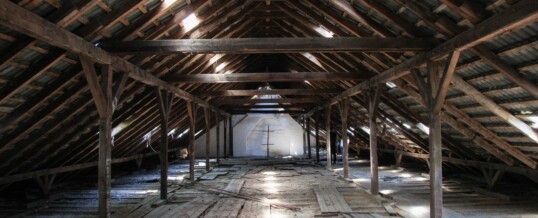
Crawl spaces and attics, what are they?
Can they both be used as storage spaces? What’s inside a crawlspace? Is having a crawl space or an attic in your home a bad thing? These are some of the most common questions people have about these two installations.
If you want to know the difference between the two, or what you can do with your crawl space (or if you should even have one), you’ve come to the right place.
Let’s look at the differences between attics and crawl spaces and clear up some of the most common misconceptions about the two.
What Is a Crawl Space?
Lots of people tend to think crawl spaces are another type of storage solution in your home. This isn’t strictly true.
Essentially, crawl spaces provide a barrier between your home and the ground below. You can think of them as a kind of buffer.
They’re usually made of footings and walls (typically made from concrete or cinder blocks) to support the weight of the house. They can be as high as five feet, but most tend to be between 1 and 3 feet.
Their small height is where they get their name from – most homeowners will have to crawl through and around this space to access it physically.
What Is an Attic?
An attic is a space or a room situated at the top of a house. It’s usually pitched below the roof of a home, and they’re sometimes also called garrets or sky parlors.
The average attic is around 70 square feet with a minimum height and width of 7 feet. Attics are usually made from the same primary building material as your house.
Attics should be adequately heated and ventilated from the central part of the house. This will keep the temperature regulated and your energy bills low.
What’s Stored In a Crawl Space?
Crawl spaces can provide access to repair plumbing, electrical wiring, and heating and cooling systems. They’re a functional alternative to a traditional basement – and they’re usually more cost-effective, too.
Essentially, it’s an area to store and conceal the ‘guts’ of your home. They’re usually vented to outside air, and they’re typically unfurnished with dirt floors.
What’s Stored In an Attic?
Attics have a much broader scope of storage potential. Essentially, you can store anything in your attic that’s impervious to heat.
This could be unused furniture, Christmas decorations, old electricals, or anything you don’t often use around the home that needs a storage space.
In modern homes, most attics have at least one electrical outlet and a wall light switch. Homeowners often install more electrical outlets to convert their attic into a functional room, like an office or a spare bedroom.
Why Do Homes Have a Crawl Space?
There are two main reasons homes have crawl spaces:
- Cost
- Accessibility
Not only is all the unattractive electrical wiring of your home neatly stored away, but your home is built off the ground. This allows air to circulate beneath your home.
This has a few benefits, including the following:
It’s cheap: Things can get expensive if you need to move the dirt to make a level slope for concrete. A crawlspace eliminates the need to do this.
It’s convenient: Not only are the ‘guts’ of your house stored away neatly, but their placement can make future repairs and installations much easier for professionals.
Attics: The Pros and Cons
Now, let’s take a closer look a the pros and cons of having an attic in your home.
Pros:
- They provide extra storage space.
- Finished attics increase the home’s ability to retain heat, saving you costs on your energy bills.
- Attics are versatile and can be easily converted into other rooms.
Cons:
- Attics have complex designs (like sloped roofs). This can make conversions difficult, and they’ll often require a lot of planning.
- Electrical installations can be complicated.
Lastly, the attic is one of the most vulnerable rooms in the home. Without adequate protection, your attic and the valuables inside it are at risk from falling trees/debris and water damage.
Crawlspaces: The Pros and Cons
So, what are the pros and cons of owning a crawlspace? Let’s take a look.
Pros:
- They’re a convenient storage solution for wiring.
- Contractors will find it easier to perform repairs.
- They prevent pests from entering your home thanks to their airtight barriers.
Cons:
- They require more maintenance to ensure they’re correctly insulated.
- When you install a crawlspace, your HVAC systems may need to be updated to ensure air is circulating throughout your home efficiently.
Lastly, if you’re renovating, they may take up room you previously used as storage, reducing the amount of free space in your home.
Protecting Your Crawlspace
Crawlspaces are one of the most vulnerable aspects of your home. Unfortunately, homes that are built over crawl spaces can suffer from issues with moisture. Some of the most common problems found in crawlspaces are:
- Mold and mildew
- Floor failure
- Wood rot and structural damage
- Dust mites
- Allergy aggravation
To prevent damage to your crawlspace, you should use vapor barriers and dehumidifiers. These can reduce the amount of moisture and negate the associated risks mentioned above.
You should also consult a professional and make sure your gutters and downspouts are correctly positioned and ensure it’s adequately insulated.
Attic vs Crawl Space: Find Out More
So, there you have it. We hope having read this article you now have a better idea of the differences between an attic and a crawl space.
Whether you’re planning a renovation or want to know more about attics and crawl spaces, their key features, and their potential for improvement, why not contact us today?
ShareJUN
